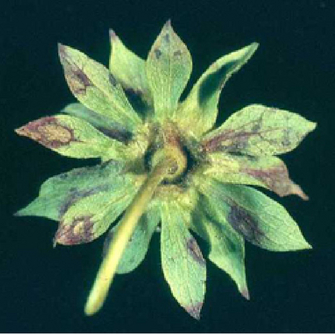Angular leaf spot (ALS) of strawberry
Xanthomonas fragariae
Damage symptoms
The leaf symptoms are typical and easily recognizable in the field, but do not always occur:
On the underside of the leaf, there are 1-4 mm angular watery spots bordered by the leaf veins that appear translucent in backlighting and black in incident light. In high humidity or precipitation, a cream to yellow bacterial slime, later turning brown, may ooze. Symptoms may spread along the leaf veins and lead to extensive leaf death. The leaves turn reddish brown and tear.
Usually, no discoloration is visible on rhizomes. Starting from the leaves and petioles, the leading tissue of the rhizome can also be infected in exceptional cases. This results in localized waterlogged spots in the rhizome. These are often confined to one side of the rhizome. In plants with advanced infection, severe browning can be seen in the rhizome section. However, such severe symptom expression is observed only in rare cases and is usually triggered only by overcropping.
Browning may occur on fruit sepals in externally healthy fruit. However, this symptom is not specific and may also be caused by various other leaf spot pathogens. Infestation of the sepals reduces the marketability of the fruit.




Distribution
The angular leaf spot disease of strawberry occurs worldwide.
In Europe, Xanthomonas fragariae occurs locally in almost all countries.
The disease is of little importance in areas with little rainfall and drip irrigation. However, it can become a problem in strawberry fields with sprinkler irrigation or in areas with frequent rainfall during the summer months.
Propagation and transmission
The pathogen is spread over a large area by infected planting material and over a small area in the field by bacterial droplets carried from plant to plant by wind, insects or during harvesting.
The first infections start in spring from old leaves or the crown area of infected plants, with daytime temperatures around 20 °C and low nighttime temperatures accelerating the development of the bacterium in spring. Infection of young leaves usually occurs through droplets during rain or overcrown irrigation. The bacteria contained in the droplets penetrate the leaf through the stomata. Under favorable climatic conditions, several cycles of the disease are possible.
Economic importance
The pathogen is transferred from the mother plant to the young plants during propagation and is therefore of phytosanitary importance. In fruit production, the angular leaf spot disease of strawberry only poses a threat to the infested field during very high rainfall. Infestation leads to a reduction in leaf area and, under certain circumstances, to lower yield. In case of heavy infestation, quality losses may occur due to infection of the sepals. If preventive measures regarding irrigation are observed, the economic damage in fruit cultivation is usually low.
Prevention and control
- Purchase of controlled certified seedlings.
- Extended crop rotation. Field plots found to be infested with Xanthomonas fragariae should not be used for strawberry production for at least two seasons.
- Avoid multi-row planting systems or wind-sheltered, enclosed sites and reduce nitrogen fertilization.
- Irrigation: prefer drip irrigation, irrigate in the morning rather than in the evening to ensure faster drying
- Regular control of infestation during cultivation
- The spread of angular leaf spot disease can be reduced by treatment with registered copper preparations (see list of plant protection products approved in Austria) from the beginning of flower stem shoots to flowering
- diseased plants should be removed
Last updated: 25.05.2023
automatically translated